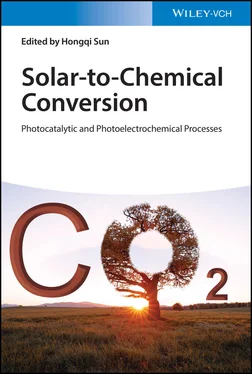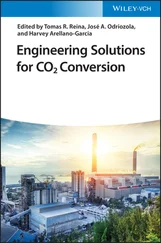1 ...6 7 8 10 11 12 ...32 Print ISBN:978‐3‐527‐34718‐6
ePDF ISBN:978‐3‐527‐82509‐7
ePub ISBN:978‐3‐527‐82508‐0
oBook ISBN:978‐3‐527‐82507‐3
Printed on acid‐free paper
10 9 8 7 6 5 4 3 2 1
1
Introduction: A Delicate Collection of Advances in Solar‐to‐Chemical Conversions
Hongqi Sun
Edith Cowan University, School of Engineering, 270 Joondalup Drive, Joondalup, WA, 6027, Australia
Tremendous efforts have been made by worldwide researchers toward effective solar energy conversion and utilization. Compared with solar panels or solar cells that convert solar energy to electricity, photocatalytic process can store solar energy to chemical energies and then has attracted extensive attention. This book seizes this great timing to delicately collect the fundaments of solar‐to‐chemical technologies. Researchers, students, and broad readership would use this book to become experts from beginners. The researchers in the fields and the community may also find it useful for further advances to this exciting area.
This book will cover the fundamentals in solar energy conversion to chemicals, either fuels or chemical products. Natural photosynthesis will be firstly presented to give a tutorial introduction while main attention will be focused on artificial processes for solar energy conversion and utilization. The chemical processes of solar energy conversion via homogeneous and/or heterogeneous photocatalysis will be described with the mechanistic insights. Reaction systems afford a variety of applications, for example, water splitting for hydrogen or oxygen evolution, photocatalytic CO 2reduction to fuels, and light‐driven N 2fixation, etc. Emerging photocatalysis in upgrading or reforming fossil fuels will also be covered. Design and theoretical fundamentals of solar energy conversion to chemicals will be explained in detail based on semiconductor photocatalysis. Enormous research outcomes in the individual field are related to solar‐to‐chemical conversion, while this might be the first delicate collection detailing the fundamentals of each catalytic process, along with most challenging issues that hinder the processes move to an industrial scale. Therefore, it is believed that this book will be unique and can offer the readers a broad view of solar energy utilization based on chemical processes and their perspectives for future sustainability.
This book includes 16 chapters and the brief information and highlights of each chapter are as follows:
Chapter 1: Introduction: A Delicate Collection of Advances in Solar‐to‐Chemical Conversions. This chapter briefs the background of this book, introduces the objectives, and provides the main information of each chapter of the book. It is expected that the readers would have a general idea of this book and can then directly move to the specific contents for perusing. It is anticipated that this chapter alone can work as the abstract of the book.
Chapter 2: Artificial Photosynthesis and Solar Fuels. This chapter contributes to the conceptual processes in the conversion of solar energy into chemical energies, i.e. solar fuels. The engineered processes mimicking natural photosynthesis mark the term of artificial photosynthesis. The basic principles for converting carbon dioxide and water into value‐added solar fuels, which can be hydrogen, oxygen, and hydrocarbons, are outlined. The core of the technology is photocatalysis, typically being facilitated by semiconductor materials. Via the process, a variety of solar fuel products can be produced. They may include (i) hydrocarbons (methane, methanol, formaldehyde, formic acid, and C2), (ii) carbon monoxide, (iii) oxygen, and (iv) hydrogen. This is because of the multi‐electron, multi‐hole, and multi‐proton reactions. The mechanism and selectivity were examined. The strategies for facing the challenges in this exciting area were proposed at the end of the chapter.
Chapter 3: Natural and Artificial Photosynthesis. This chapter provides an overview of the most important process, i.e. natural photosynthesis. Such a process has been literally powered the whole planet with various species and the ecosystem. It introduces the detailed processes, including light harvesting, charge separation and accumulation, water oxidation, and nitrogen fixation. With the insights into them, inspirations are achieved for artificial photosynthesis, which leads to the fantastic explorations on solar‐to‐chemical conversions.
Chapter 4: Photocatalytic Hydrogen Evolution. This chapter mainly introduces heterogeneous photocatalytic reactions for hydrogen evolution. The basic principles involved in photocatalytic hydrogen evolutions are introduced. Following that, photocatalytic hydrogen evolution reactions under ultraviolet (UV) light, visible light, and near‐infrared light irradiations were investigated in detail. Because of the light absorption ability, which is determined by the band gap of a semiconductor, specific semiconductors only work better in a specific condition. As a result, titanium dioxide and its modified counterparts are mainly introduced in UV reactions, carbon nitride and various modified ones are presented in visible‐light photocatalysis, and upconversion materials are discussed for near‐infrared light reactions. Comprehensive survey on materials for the specific light regions was also available. For providing the insights into the reactions, the roles of sacrificial reagents and reaction pathways were also discussed in this chapter.
Chapter 5: Photoelectrochemical Hydrogen Evolution. The status, opportunities, and challenges in the hydrogen energy are discussed. Other than powdered photocatalysis, this chapter concerns photoelectrochemical (PEC) and photovoltaic‐driven water electrocatalysis (PV + EC). The key of these processes is the efficient photoelectrode fabrication, which determines the light harvest, charge separation and transfer, and surface reactions. The configurations of PEC and the strategies for promoting charge transfer through the semiconductor film and providing strong driving force for carriers' separation are reviewed. The catalyst design for achieving such strategies was paid with extra attention.
Chapter 6: Photocatalytic Oxygen Evolution. Water oxidation half‐reaction has been regarded to be the primary barrier in solar fuel production, because such a reaction requires multiple protons and electrons to be involved. This chapter identifies the critical challenge of water oxidation to be the design of efficient, low‐cost catalysts with excellent stability. The morphology, structure, and photocatalytic water oxidation performances of various earth‐abundant materials are reviewed. Both homogeneous and heterogeneous reactions are discussed. Moreover, quantum size effect, localized surface plasmon resonance, active facet exposure defect engineering, and heterojunction construction in low‐dimensional materials are discussed in terms of enhanced photocatalytic water oxidation.
Chapter 7: Photoelectrochemical Oxygen Evolution. This chapter reviews the fundamentals of PEC oxygen evolution toward higher efficiencies as compared with powdered or homogeneous photocatalytic oxygen evolution. It discusses the factors affecting the photoanodic current, the relationship between electrode potentials and pH in the electrolyte, the evaluation method of PEC performance of photoanode materials, the relationship between flat band potential and photocurrent onset potential, the selection strategy of photoanode materials, and PEC device for water splitting. The determining parameters, such as nanostructuring, morphology control, donor doping, cocatalyst loading, heterojunction formation, and electron‐conductive materials, are discussed for better design of photoanode materials. It concludes that the rational material design and the knowledge of thermodynamics and kinetics are required and the low‐cost photoanode materials composed of inexpensive earth‐abundant elements control the feasibility of this technology.
Читать дальше


![Евгений Матерёв - Музеи… или вдохновляющая музыка The Chemical Brothers [litres самиздат]](/books/437288/evgenij-materev-muzei-ili-vdohnovlyayuchaya-muzyka-th-thumb.webp)









